SUBMARINE TECHNOLOGY
Propulsion
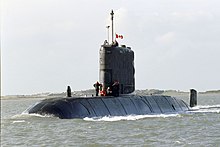 |
| HMCS Windsor , a Royal Canadian Navy Victoria-class diesel-electric hunter-killer submarine |
The first submarines were propelled through humans. The first routinely driven submarine changed into the 1863 French Plongeur, which used compressed air for propulsion. Anaerobic propulsion turned into first hired through the Spanish Ictineo II in 1864, which used an answer of zinc, manganese dioxide, and potassium chlorate to generate enough warmness to strength a steam engine, whilst also presenting oxygen for the crew. A similar gadget changed into now not hired again until 1940 whilst the German Navy examined a hydrogen peroxide-based gadget, the Walter turbine, on the experimental V-80 submarine and later on the naval U-791 and sort XVII submarines; the device changed into in addition advanced for the British Explorer-elegance, finished in 1958.
Until the advent of nuclear marine propulsion, most twentieth-century submarines used electric powered automobiles and batteries for strolling underwater and combustion engines at the floor, and for battery recharging. Early submarines used fuel (petrol) engines but this fast gave manner to kerosene (paraffin) after which diesel engines because of reduced flammability and, with diesel, improved fuel-performance and therefore also extra variety. A mixture of diesel and electric powered propulsion have become the norm.
Initially, the combustion engine and the electric motor had been in maximum cases connected to the identical shaft in order that both ought to without delay force the propeller. The combustion engine become located on the the front end of the stern segment with the electric motor in the back of it observed by the propeller shaft. The engine became connected to the motor via a grasp and the motor in flip linked to the propeller shaft by using any other seize.
With best the rear snatch engaged, the electric motor ought to force the propeller, as required for absolutely submerged operation. With each clutches engaged, the combustion engine should force the propeller, as was possible when operating on the floor or, at a later stage, whilst snorkeling. The electric powered motor might in this case serve as a generator to rate the batteries or, if no charging was wanted, be allowed to rotate freely. With most effective the the front grab engaged, the combustion engine ought to power the electrical motor as a generator for charging the batteries with out simultaneously forcing the propeller to transport.
The motor could have more than one armatures at the shaft, which might be electrically coupled in series for slow speed and in parallel for excessive velocity (those connections have been called "group down" and "group up", respectively).
Diesel-electric transmission
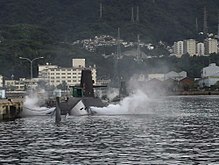 |
| Recharging battery ( JMSDF ) |
While maximum early submarines used an immediate mechanical connection among the combustion engine and the propeller, an alternative answer changed into considered as well as implemented at a totally early degree. That solution is composed in first changing the paintings of the combustion engine into electric power through a committed generator. This electricity is then used to pressure the propeller via the electrical motor and, to the extent required, for charging the batteries. In this configuration, the electric motor is consequently responsible for using the propeller always, no matter whether or not air is available so that the combustion engine can also be used or now not.
Among the pioneers of this opportunity answer turned into the first actual submarine of the Swedish Navy, HMS Hajen (later renamed Ub number 1), launched in 1904. While its layout was typically stimulated by way of the primary submarine commissioned by way of the US Navy, USS Holland, it deviated from the latter in at the least three big ways: via adding a periscope, with the aid of changing the gasoline engine by means of a semidiesel engine (a warm-bulb engine normally supposed to be fueled by using kerosene, later changed by using a true diesel engine) and by severing the mechanical hyperlink between the combustion engine and the propeller by way of as an alternative letting the previous force a devoted generator. By so doing, it took three tremendous steps closer to what become eventually to turn out to be the dominant technology for conventional (i.E., non-nuclear) submarines.
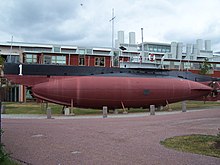 | |
| One of the first submarines with diesel–electric transmission, HMS Hajen, on show outdoor Marinmuseum in Karlskrona |
In the following years, the Swedish Navy brought any other seven submarines in three extraordinary instructions (2nd class, Laxen elegance, and Braxen class) the use of the identical propulsion technology but equipped with actual diesel engines as opposed to semidiesels from the outset. Since via that time, the generation was normally based at the diesel engine rather than a few different type of combustion engine, it subsequently got here to be known as diesel–electric transmission.
Like many other early submarines, those to start with designed in Sweden were pretty small (much less than 2 hundred tonnes) and for that reason limited to littoral operation. When the Swedish Navy desired to add large vessels, capable of working similarly from the shore, their designs had been purchased from agencies abroad that already had the specified revel in: first Italian (Fiat-Laurenti) and later German (A.G. Weser and IvS). As a facet-impact, the diesel–electric transmission become temporarily deserted.
However, diesel–electric powered transmission turned into without delay reintroduced when Sweden commenced designing its very own submarines again inside the mid 1930s. From that point onwards, it's been always used for all new classes of Swedish submarines, albeit supplemented with the aid of air-independent propulsion (AIP) as supplied with the aid of Stirling engines beginning with HMS Näcken in 1988.
 |
| Two widely special generations of Swedish submarines however both with diesel–electric powered transmission: HMS Hajen, in carrier 1905–1922, and HMS Neptun, in carrier 1980-1998 |
Another early adopter of diesel–electric powered transmission become the US Navy, whose Bureau of Engineering proposed its use in 1928. It became ultimately tried within the S-elegance submarines S-3, S-6, and S-7 before being positioned into production with the Porpoise magnificence of the Nineteen Thirties. From that factor onwards, it continued for use on most US conventional submarines.
Apart from the British U-magnificence and some submarines of the Imperial Japanese Navy that used separate diesel generators for low speed strolling, few navies other than those of Sweden and the United States made a good deal use of diesel–electric powered transmission earlier than 1945. After World War II, via evaluation, it steadily have become the dominant mode of propulsion for traditional submarines. However, its adoption became no longer constantly swift. Notably, the Soviet Navy did no longer introduce diesel–electric powered transmission on its traditional submarines till 1980 with its Paltus elegance.
If diesel–electric powered transmission had best added blessings and no hazards in contrast with a gadget that mechanically connects the diesel engine to the propeller, it'd undoubtedly have end up dominant tons earlier. The dangers include the following:
* It involves a loss of fuel-efficiency as well as electricity by way of converting the output of the diesel engine into strength. While both mills and electric powered motors are acknowledged to be very efficient, their efficiency though falls quick of one 100 percentage.
* It calls for a further issue within the shape of a dedicated generator. Since the electric motor is usually used to force the propeller it is able to not step in to tackle generator carrier as nicely.
* It does no longer permit the diesel engine and the electrical motor to sign up for forces with the aid of concurrently driving the propeller mechanically for optimum pace when the submarine is surfaced or snorkeling. This may, but, be of little realistic importance inasmuch as the choice it prevents is one that could go away the submarine at a hazard of getting to dive with its batteries at the least partially depleted.
The reason why diesel–electric transmission has emerge as the dominant opportunity in spite of those dangers is of route that it also comes with many benefits and that, on balance, these have subsequently been determined to be extra important. The advantages include the following:
* It reduces external noise through severing the direct and inflexible mechanical hyperlink among the incredibly noisy diesel engine(s) on the only hand and the propeller shaft(s) and hull on the alternative. With stealth being of paramount significance to submarines, this is a completely huge benefit.
* It will increase the readiness to dive, that is of direction of important significance for a submarine. The most effective thing required from a propulsion factor of view is to shut down the diesel(s).
* It makes the velocity of the diesel engine(s) temporarily unbiased of the speed of the submarine. This in turn often makes it viable to run the diesel(s) at near best speed from a gasoline-efficiency in addition to sturdiness factor of view. It also makes it possible to lessen the time spent surfaced or snorkeling by running the diesel(s) at maximum velocity without affecting the speed of the submarine itself.
* It eliminates the clutches in any other case required to attach the diesel engine, the electrical motor, and the propeller shaft. This in turn saves space, will increase reliability and reduces upkeep costs.
* It will increase flexibility with reference to how the driveline additives are configured, located, and maintained. For instance, the diesel not must be aligned with the electrical motor and propeller shaft, two diesels can be used to energy a unmarried propeller (or vice versa), and one diesel may be grew to become off for renovation as long as a 2nd is to be had to offer the required amount of power.
* It helps the integration of extra primary resources of power, beside the diesel engine(s), such as diverse types of air independent power (AIP) systems. With one or extra electric motors constantly riding the propeller(s), such structures can without difficulty be added as but any other supply of electric strength similarly to the diesel engine(s) and the batteries.
Snorkel
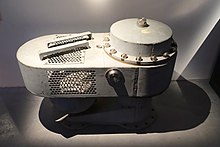 |
| Head of the snorkel mast from German type XXI submarine U-3503, scuttled out of doors Gothenburg on 8 May 1945 however raised through the Swedish Navy and punctiliously studied for the cause of improving destiny Swedish submarine designs |
During World War II the Germans experimented with the concept of the schnorchel (snorkel) from captured Dutch submarines but did now not see the need for them till alternatively late in the battle. The schnorchel is a retractable pipe that components air to the diesel engines even as submerged at periscope depth, allowing the boat to cruise and recharge its batteries whilst retaining a diploma of stealth.
Especially as first implemented but, it grew to become out to be a long way from a really perfect answer. There have been troubles with the tool's valve sticking close or remaining because it dunked in tough weather. Since the gadget used the complete strain hull as a buffer, the diesels would straight away suck huge volumes of air from the boat's compartments, and the group regularly suffered painful ear injuries. Speed turned into restrained to 8 knots (15 km/h), lest the tool snap from pressure. The schnorchel additionally created noise that made the boat less complicated to discover with sonar, yet greater tough for the on-board sonar to come across signals from other vessels. Finally, allied radar sooner or later have become sufficiently superior that the schnorchel mast may be detected beyond visible range.
While the snorkel renders a submarine some distance much less detectable, it is consequently now not ideal. In clear weather, diesel exhausts can be seen at the floor to a distance of about 3 miles, at the same time as "periscope feather" (the wave created via the snorkel or periscope moving thru the water) is seen from a ways off in calm sea situations. Modern radar is also able to detecting a snorkel in calm sea situations.
The trouble of the diesels inflicting a vacuum in the submarine whilst the top valve is submerged nonetheless exists in later version diesel submarines however is mitigated through high-vacuum cut-off sensors that shut down the engines whilst the vacuum in the ship reaches a pre-set point. Modern snorkel induction masts have a fail-safe layout the usage of compressed air, controlled with the aid of a simple electric circuit, to maintain the "head valve" open towards the pull of a powerful spring. Seawater washing over the mast shorts out uncovered electrodes on pinnacle, breaking the control, and shutting the "head valve" while it's far submerged. US submarines did now not undertake the usage of snorkels till after WWII.
Air-independent propulsion
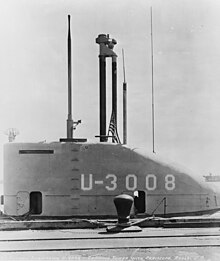 |
| USS U-3008 (former German submarine U-3008) along with her snorkel masts raised at Portsmouth Naval Shipyard, Kittery, Maine |
During World War II, German Type XXI submarines (also referred to as "Elektroboote") have been the primary submarines designed to perform submerged for prolonged intervals. Initially they had been to hold hydrogen peroxide for long-time period, speedy air-impartial propulsion, but had been in the end built with very huge batteries as an alternative. At the stop of the War, the British and Soviets experimented with hydrogen peroxide/kerosene (paraffin) engines that could run surfaced and submerged. The results had been now not encouraging. Though the Soviet Union deployed a class of submarines with this engine type (codenamed Quebec with the aid of NATO), they had been considered unsuccessful.
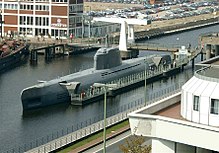 |
| German Type XXI submarine |
The United States also used hydrogen peroxide in an experimental midget submarine, X-1. It changed into firstly powered by using a hydrogen peroxide/diesel engine and battery system till an explosion of her hydrogen peroxide deliver on 20 May 1957. X-1 become later converted to apply diesel–electric powered pressure.
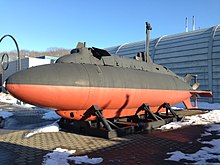 |
| American X-1 Midget Submarine |
Today numerous navies use air-impartial propulsion. Notably Sweden makes use of Stirling generation at the Gotland-class and Södermanland-class submarines. The Stirling engine is heated by way of burning diesel gas with liquid oxygen from cryogenic tanks. A more recent development in air-unbiased propulsion is hydrogen gasoline cells, first used on the German Type 212 submarine, with 9 34 kW or two one 120 kW cells. Fuel cells also are used in the new Spanish S-80-elegance submarines although with the gas saved as ethanol after which converted into hydrogen earlier than use.
One new era this is being added beginning with the Japanese Navy's 11th Sōryū-class submarine (JS Ōryū) is a more modern-day battery, the lithium-ion battery. These batteries have about double the electrical storage of conventional batteries, and via converting out the lead-acid batteries in their normal storage regions plus filling up the big hull space generally devoted to AIP engine and gas tanks with many heaps of lithium-ion batteries, contemporary submarines can really return to a "natural" diesel–electric powered configuration yet have the introduced underwater range and strength usually associated with AIP ready submarines.
Nuclear power
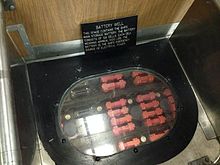 |
| Battery well containing 126 cells on USS Nautilus, the first nuclear-powered submarine |
Steam strength became resurrected in the Nineteen Fifties with a nuclear-powered steam turbine driving a generator. By getting rid of the want for atmospheric oxygen, the time that a submarine could stay submerged become restrained handiest by using its meals stores, as respiratory air turned into recycled and fresh water distilled from seawater. More importantly, a nuclear submarine has unlimited variety at pinnacle speed. This permits it to tour from its operating base to the fight area in a far shorter time and makes it a much more hard target for maximum anti-submarine guns. Nuclear-powered submarines have a especially small battery and diesel engine/generator powerplant for emergency use if the reactors need to be shut down.
Nuclear electricity is now utilized in all massive submarines, however due to the high value and huge length of nuclear reactors, smaller submarines nevertheless use diesel–electric powered propulsion. The ratio of larger to smaller submarines relies upon on strategic needs. The US Navy, French Navy, and the British Royal Navy perform only nuclear submarines, that's defined by the need for remote operations. Other most important operators rely upon a mix of nuclear submarines for strategic functions and diesel–electric powered submarines for protection. Most fleets haven't any nuclear submarines, because of the confined availability of nuclear power and submarine generation.
Diesel–electric powered submarines have a stealth gain over their nuclear counterparts. Nuclear submarines generate noise from coolant pumps and faster-equipment had to operate the reactor, even at low power tiers. Some nuclear submarines inclusive of the American Ohio magnificence can operate with their reactor coolant pumps secured, making them quieter than electric subs. A conventional submarine running on batteries is nearly completely silent, the simplest noise coming from the shaft bearings, propeller, and flow noise across the hull, all of which stops whilst the sub hovers in mid-water to pay attention, leaving handiest the noise from team hobby. Commercial submarines normally depend simplest on batteries, on account that they function along with a mother ship.
Several extreme nuclear and radiation accidents have worried nuclear submarine mishaps. The Soviet submarine K-19 reactor coincidence in 1961 ended in eight deaths and extra than 30 different human beings were over-uncovered to radiation. The Soviet submarine K-27 reactor twist of fate in 1968 led to nine fatalities and eighty three different injuries. The Soviet submarine K-431 twist of fate in 1985 led to 10 fatalities and 49 other radiation accidents.
Alternative
Oil-fired steam turbines powered the British K-class submarines, constructed all through World War I and later, to offer them the surface pace to keep up with the struggle fleet. The K-elegance subs had been not very successful, but.
Toward the end of the twentieth century, some submarines—together with the British Vanguard magnificence—began to be outfitted with pump-jet propulsors in place of propellers. Though these are heavier, extra luxurious, and much less efficient than a propeller, they're significantly quieter, imparting an important tactical benefit.
Armament
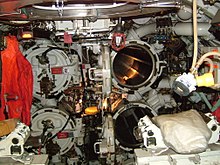 |
| The forward torpedo tubes in HMS Ocelot |
The achievement of the submarine is inextricably linked to the improvement of the torpedo, invented via Robert Whitehead in 1866. His invention is largely the same now because it became a hundred and forty years in the past. Only with self-propelled torpedoes may want to the submarine make the leap from novelty to a weapon of warfare. Until the perfection of the guided torpedo, more than one "instantly-going for walks" torpedoes were required to attack a target. With at maximum 20 to twenty-five torpedoes saved on board, the number of attacks turned into restrained. To increase fight endurance maximum World War I submarines functioned as submersible gunboats, the usage of their deck weapons against unarmed goals, and diving to escape and interact enemy warships. The significance of weapons endorsed the development of the unsuccessful Submarine Cruiser including the French Surcouf and the Royal Navy's X1 and M-magnificence submarines. With the appearance of anti-submarine warfare (ASW) aircraft, guns became greater for protection than attack. A extra practical technique of growing fight patience changed into the external torpedo tube, loaded only in port.
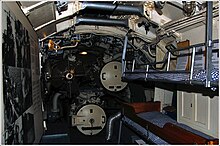 |
| The torpedo room of Vesikko |
The capacity of submarines to approach enemy harbours covertly led to their use as minelayers. Minelaying submarines of World War I and World War II were specifically built for that cause. Modern submarine-laid mines, along with the British Mark 5 Stonefish and Mark 6 Sea Urchin, can be deployed from a submarine's torpedo tubes.
After World War II, each the United States and the united states experimented with submarine-released cruise missiles such as the SSM-N-8 Regulus and P-5 Pyatyorka. Such missiles required the submarine to surface to fire its missiles. They were the forerunners of present day submarine-released cruise missiles, which can be fired from the torpedo tubes of submerged submarines, as an instance, the US BGM-109 Tomahawk and Russian RPK-2 Viyuga and versions of surface-to-surface anti-ship missiles which includes the Exocet and Harpoon, encapsulated for submarine release. Ballistic missiles can also be fired from a submarine's torpedo tubes, for example, missiles including the anti-submarine SUBROC. With inner quantity as restricted as ever and the desire to hold heavier warloads, the concept of the outside launch tube became revived, typically for encapsulated missiles, with such tubes being positioned between the internal pressure and outer streamlined hulls.
The strategic mission of the SSM-N-eight and the P-five became taken up by means of submarine-launched ballistic missile beginning with america Navy's Polaris missile, and ultimately the Poseidon and Trident missiles.
Germany is operating at the torpedo tube-released brief-variety IDAS missile, which may be used against ASW helicopters, in addition to surface ships and coastal targets.
Sensors
A submarine will have a ramification of sensors, depending on its missions. Modern military submarines depend nearly totally on a set of passive and lively sonars to discover goals. Active sonar is predicated on an audible "ping" to generate echoes to reveal gadgets around the submarine. Active structures are not often used, as doing so well-knownshows the sub's presence. Passive sonar is a set of sensitive hydrophones set into the hull or trailed in a towed array, generally trailing numerous hundred toes at the back of the sub. The towed array is the mainstay of NATO submarine detection systems, as it reduces the flow noise heard through operators. Hull established sonar is hired further to the towed array, because the towed array can not paintings in shallow depth and during maneuvering. In addition, sonar has a blind spot "via" the submarine, so a gadget on each the front and back works to eliminate that trouble. As the towed array trails at the back of and under the submarine, it additionally lets in the submarine to have a device each above and below the thermocline at the right depth; sound passing through the thermocline is distorted resulting in a decrease detection variety.
Submarines additionally carry radar equipment to stumble on floor ships and plane. Submarine captains are much more likely to apply radar detection equipment than lively radar to stumble on targets, as radar can be detected a ways beyond its very own return variety, revealing the submarine. Periscopes are not often used, besides for function fixes and to verify a touch's identity.
Civilian submarines, which includes the DSV Alvin or the Russian Mir submersibles, rely upon small energetic sonar sets and viewing ports to navigate. The human eye can not locate sunlight beneath approximately three hundred ft (91 m) underwater, so excessive depth lights are used to illuminate the viewing place.
Navigation
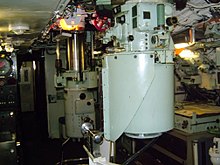 |
| The larger seek periscope, and the smaller, less detectable assault periscope on HMS Ocelot |
Early submarines had few navigation aids, but present day subs have an expansion of navigation systems. Modern army submarines use an inertial steering device for navigation at the same time as submerged, however waft blunders necessarily builds over the years. To counter this, the group once in a while uses the Global Positioning System to reap an correct role. The periscope—a retractable tube with a prism machine that gives a view of the floor—is simplest used from time to time in modern-day submarines, since the visibility range is brief. The Virginia-class and Astute-elegance submarines use photonics masts instead of hull-penetrating optical periscopes. These masts should nevertheless be deployed above the floor, and use electronic sensors for visible light, infrared, laser range-finding, and electromagnetic surveillance. One gain to hoisting the mast above the floor is that whilst the mast is above the water the complete sub continues to be beneath the water and is an awful lot harder to discover visually or by way of radar.
Communication
Military submarines use several systems to speak with distant command centers or different ships. One is VLF (very low frequency) radio, which can attain a submarine either on the surface or submerged to a fairly shallow depth, normally much less than 250 feet (76 m). ELF (extremely low frequency) can attain a submarine at greater depths, but has a completely low bandwidth and is usually used to name a submerged sub to a shallower depth where VLF indicators can reach. A submarine additionally has the option of floating a long, buoyant wire antenna to a shallower depth, permitting VLF transmissions by using a deeply submerged boat.
By extending a radio mast, a submarine can also use a "burst transmission" method. A burst transmission takes only a fragment of a 2d, minimizing a submarine's chance of detection.
To speak with different submarines, a machine referred to as Gertrude is used. Gertrude is basically a sonar smartphone. Voice conversation from one submarine is transmitted through low energy audio system into the water, in which it's far detected by using passive sonars on the receiving submarine. The variety of this device might be very short, and the use of it radiates sound into the water, which may be heard via the enemy.
Civilian submarines can use comparable, albeit less powerful systems to communicate with help ships or different submersibles inside the area.
Life support systems
With nuclear power or air-independent propulsion, submarines can remain submerged for months at a time. Conventional diesel submarines should periodically resurface or run on snorkel to recharge their batteries. Most present day military submarines generate respiratory oxygen through electrolysis of water (using a device called an "Electrolytic Oxygen Generator"). Atmosphere manipulate gadget includes a CO2 scrubber, which makes use of an amine absorbent to dispose of the gasoline from air and diffuse it into waste pumped overboard. A device that makes use of a catalyst to transform carbon monoxide into carbon dioxide (removed through the carbon dioxide scrubber) and bonds hydrogen made from the ship's storage battery with oxygen within the atmosphere to supply water, is also used. An ecosystem tracking gadget samples the air from one-of-a-kind regions of the deliver for nitrogen, oxygen, hydrogen, R-12 and R-114 refrigerants, carbon dioxide, carbon monoxide, and other gases. Poisonous gases are eliminated, and oxygen is replenished with the aid of use of an oxygen bank located in a chief ballast tank. Some heavier submarines have oxygen bleed stations (forward and aft). The oxygen within the air is sometimes stored a few percent less than atmospheric awareness to reduce fire risk.
Fresh water is produced by means of both an evaporator or a reverse osmosis unit. The number one use for fresh water is to provide feedwater for the reactor and steam propulsion flora. It is also available for showers, sinks, cooking and cleansing as soon as propulsion plant wishes have been met. Seawater is used to flush bathrooms, and the ensuing "blackwater" is saved in a sanitary tank until it's far blown overboard the usage of pressurized air or pumped overboard by using using a unique sanitary pump. The blackwater-discharge device is hard to perform, and the German Type VIIC boat U-1206 changed into lost with casualties because of human blunders at the same time as using this gadget. Water from showers and sinks is saved one by one in "gray water" tanks and discharged overboard the use of drain pumps.
Trash on modern massive submarines is commonly disposed of the usage of a tube called a Trash Disposal Unit (TDU), in which it is compacted right into a galvanized steel can. At the bottom of the TDU is a big ball valve. An ice plug is ready on top of the ball valve to shield it, the cans atop the ice plug. The top breech door is close, and the TDU is flooded and equalized with sea pressure, the ball valve is opened and the cans fall out assisted by means of scrap iron weights in the cans. The TDU is also flushed with seawater to ensure it is completely empty and the ball valve is clear earlier than final the valve.
Crew
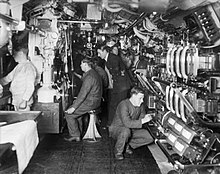 |
| The interior of a British E-elegance submarine. An officer supervises submerging operations, c. 1914–1918. |
A typical nuclear submarine has a crew of over 80; traditional boats normally have fewer than 40. The situations on a submarine may be tough because crew members should paintings in isolation for long intervals of time, with out circle of relatives touch. Submarines generally hold radio silence to keep away from detection. Operating a submarine is dangerous, even in peacetime, and lots of submarines had been misplaced in injuries.
Women
 |
| Midshipmen learn to pilot USS West Virginia |
Most navies prohibited ladies from serving on submarines, even when they were permitted to serve on floor warships. The Royal Norwegian Navy have become the primary army to allow ladies on its submarine crews in 1985. The Royal Danish Navy allowed girl submariners in 1988.[98] Others accompanied healthy which include the Swedish Navy (1989), the Royal Australian Navy (1998), the Spanish Navy (1999), the German Navy (2001) and the Canadian Navy (2002). In 1995, Solveig Krey of the Royal Norwegian Navy became the primary girl officer to count on command on a navy submarine, HNoMS Kobben.
On eight December 2011, British Defence Secretary Philip Hammond introduced that the United Kingdom's ban on women in submarines become to be lifted from 2013. Previously there were fears that girls have been more at threat from a build-up of carbon dioxide within the submarine. But a take a look at confirmed no scientific cause to exclude girls, even though pregnant ladies would nevertheless be excluded. Similar dangers to the pregnant female and her fetus barred ladies from submarine carrier in Sweden in 1983, whilst all other positions were made available for them within the Swedish Navy. Today, pregnant ladies are nonetheless not allowed to serve on submarines in Sweden. However, the policymakers notion that it become discriminatory with a widespread ban and demanded that girls should be attempted on their character deserves and feature their suitability evaluated and as compared to different candidates. Further, they mentioned that a female complying with such excessive demands is not going to emerge as pregnant. In May 2014, 3 ladies became the RN's first woman submariners.
Women have served on US Navy surface ships considering that 1993, and as of 2011–2012, commenced serving on submarines for the first time. Until currently, the Navy allowed best 3 exceptions to girls being on board navy submarines: female civilian technicians for a few days at most, women midshipmen on an overnight during summer education for Navy ROTC and Naval Academy, and family individuals for one-day established cruises. In 2009, senior officers, which includes then-Secretary of the Navy Ray Mabus, Joint Chief of Staff Admiral Michael Mullen, and Chief of Naval Operations Admiral Gary Roughead, started the system of locating a manner to enforce ladies on submarines. The US Navy rescinded its "no girls on subs" policy in 2010.
Both america and British navies perform nuclear-powered submarines that install for periods of six months or longer. Other navies that allow girls to serve on submarines perform conventionally powered submarines, which install for tons shorter intervals—normally simplest for a few months. Prior to the alternate by way of the US, no country the use of nuclear submarines approved ladies to serve on board.
In 2011, the first elegance of lady submarine officers graduated from Naval Submarine School's Submarine Officer Basic Course (SOBC) on the Naval Submarine Base New London. Additionally, greater senior ranking and experienced woman deliver officers from the surface warfare area of expertise attended SOBC as properly, proceeding to fleet Ballistic Missile (SSBN) and Guided Missile (SSGN) submarines at the side of the brand new female submarine line officers beginning in past due 2011. By past due 2011, numerous girls had been assigned to the Ohio-magnificence ballistic missile submarine USS Wyoming. On 15 October 2013, the United States Navy announced that of the smaller Virginia-class attack submarines, USS Virginia and USS Minnesota, might have lady team-contributors with the aid of January 2015.
In 2020, Japan's country wide naval submarine academy familiar its first girl candidate.
Abandoning the vessel
 |
| Submarine Escape Immersion Equipement suit Mk 10 |
In an emergency, submarines can transmit a signal to different ships. The team can use escape units which includes the Submarine Escape Immersion Equipment to desert the submarine via an get away trunk, which is is a small airlock compartment that gives a path for group to get away from a downed submarine at ambient strain in small companies, whilst minimising the quantity of water admitted to the submarine. The crew can avoid lung injury from over-growth of air inside the lungs because of the stress alternate referred to as pulmonary barotrauma by way of keeping an open airway and exhaling all through the ascent. Following get away from a pressurized submarine, wherein the air strain is higher than atmospheric due to water ingress or different reasons, the team is vulnerable to growing decompression sickness on go back to surface pressure.
An opportunity get away method is thru a deep-submergence rescue vehicle which could dock onto the disabled submarine, establish a seal around the get away hatch, and transfer employees on the same pressure because the indoors of the submarine. If the submarine has been pressurised the survivors can lock into a decompression chamber on the submarine rescue deliver and transfer beneath strain for safe floor decompression.
WRITTEN BY : ADRISH WAHEED
Labels: SUBMARINE TECHNOLOGY

0 Comments:
Post a Comment
Subscribe to Post Comments [Atom]
<< Home